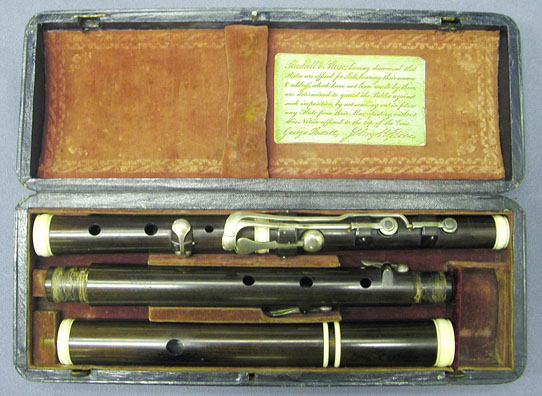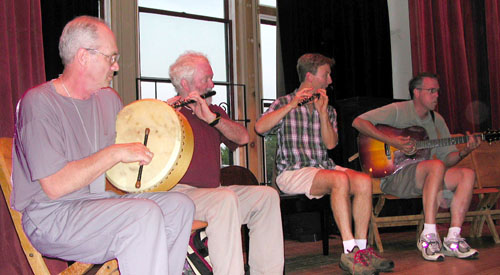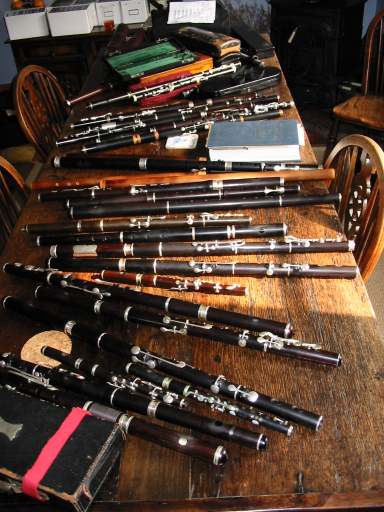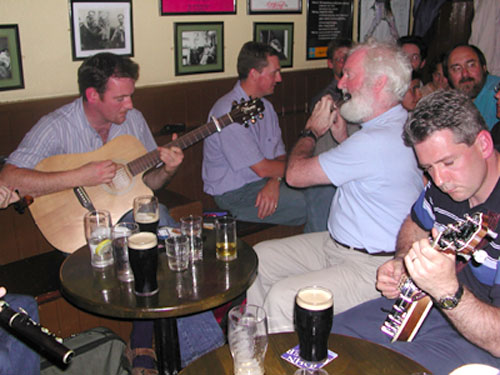I decided to leave the relative safety of my workshop in July and
August 2002, to venture out to see what the rest of the world was up
to. This is a short report about the tour.
What were the aims of the trip?
- spend a lot of time in the major flute collections in the
US, England and Scotland, measuring and gathering information
- progress some work with my international research colleagues,
- meet some of my past and future customers
- attend a few festivals where flutes and flute-players abound,
- meet any flute makers and flute-players convenient to my trajectory
- eat, drink, session and be merry, as time, opportunity and energy
permit!
Where did I go?
The trip took me to 25 places in 5 countries: Sydney, Los Angeles, San
Francisco, Vancouver, Victoria, Seattle, Chicago, Rochester, Washington,
Baltimore, Philadelphia, Boston, East Durham (NY), Nova Scotia, London,
Dublin, Achill Island (Co. Mayo), Belfast, Edinburgh, Glasgow, Manchester,
Leominster, Bedford, Oxford and Brisbane.
What was achieved?
Over 64 days away, I:
- measured and studied 113 flutes in 24 days in 14 collections,
- took 500 digital images of flutes and related things
- collected about a ream of photocopies of period documents
- acquired a number of books and catalogues pertaining to flutes
- discussed flute and whistle issues with 12 makers
- attended 6 public events and 8 specifically organised for me
- met hundreds of players and teachers
- took about 8 months worth of orders
- and played in 32 sessions!
Collections visited:
The major collections were:
- Rick Wilson collection, LA (2 days)
- Helen Valenza collection, Rochester (1 day)
- The Dayton C Miller Collection at the Library of Congress in
Washington DC (9 days)
- Horniman Museum, London (2 days)
- Royal College of Music, London (1 day)
- Edinburgh University Collection (3 days)
- Royal Northern College of Music, Manchester (1 day)
- Bate Collection, Oxford (5 days)
in addition to 5 smaller private collections.

Measuring one of the flutes from Rick Wilson's wonderful collection.
(Rick Wilson, left, Jay Peitzer right. Picture by Kathy Wilson.)
The research aims included:
- the perpetual lookout for new and interesting models to offer
- tracing development of the conical flute in 19th century London
- tracing development within specific models in the period
- instruments shown at the Great Exhibition in 1851
On new models:
I can now offer a Bb flute, based on Rudall & Rose
instruments. I measured and studied five examples of these, in 4, 6
and 8 key versions, and Bb instruments by three other makers.
| One of
the Rudall instruments examined appears to be virtually unused and reveals excellent details
about the original embouchure treatment. |
 |
I may also decide to offer a normal pitch Rudall & Rose copy, of a
"size" somewhere between my current "Refined" and
"Perfected" models. This decision will depend on further
analysis of the many instruments measured.
On tracing flute development in the 19th century:
I gathered a vast amount of data and photographic evidence which should
reveal a lot we do not know about how the flute developed in its most
turbulent century to date. Analysis of the data will probably take
several years, with data and findings being published on this web site as
they become available.
Meeting other researchers
I enjoyed meeting other researchers and people associated with research,
including Stu Forbes in LA, Adrian Duncan in Vancouver, Robert Bigio in
London and again in Oxford, Clive Catteral in Oxford and Tony Bingham in
London. Adrian and I were able to spend a few days planning our
future work together and preparing for the official launch of the Clinton
1851 flute at Boxwood.
New initiatives and partnerships
A number of new research initiatives surfaced during the trip.
The massive amount of data collected will support these and and the
previously identified research topics for many years to come.
The trip has also thrown up some new research collaborators, whose
efforts will in future contribute to papers on this site.
Meeting other makers
It was fascinating meeting other makers and finding out what we had in
common or in difference. There are the obvious topics to discuss -
how do you do that, and why don't you do it this way. We traversed
those of course, but the more interesting topics are more subtle.
Each maker achieves their own balance of
efficiency versus care - and this is reflected in their equipment, the
quality and quantity of their output, their prices and their waiting
times. It's interesting to get into the head of another maker,
to see how they have come to the position they occupy.
I was pleased to find I occupied a place in the spectrum where I remain
comfortable - I would not want to sacrifice my current quality by speeding
up processes, nor am I attracted towards increasing the decorative values
at the cost of increasing prices and waiting times.
It was instructive too to experience the wide range of embouchure types
makers employ to satisfy very widely differing playing styles in use
around the world. This question didn't really crystallise until
quite late in the trip, and will need further discussion to resolve.
It illustrates that the wooden flute revival is as
capable of throwing up issues worthy of study as were the original times.
Major events
I attended three summer schools:
- Irish Week in East Durham in the Catskill Mountains, New York
- Boxwood - the Festival of the Wooden Flute - in Lunenberg, Nova
Scotia
- Scoil Acla, on Achill Island, Co Mayo, Eire.
| Playing for an informal ceili at Boxwood.
The fellow beside me seemed to have played flute before!
L: Richard Morton
R: Chris Norman & Andy Thurston. |
 |
While not attending with the aim of taking lessons, these summer
schools provided a
great opportunity for meeting players and teachers, promoting my work
while at the same time researching players' desires and needs. They
also presented original flutes for study. One of the benefits of
flutes in player's hands is that they are well blown in and more useful to
carry out intonation measurements and other performance studies.
Some fun photos of Boxwood appear at:
http://stlouis.missouri.org/~lgoodman/boxwood/Boxwood2002.html
Events organised for me:
Events were organised specially for me to meet local players at Los
Angeles, San Francisco, University of Victoria, Seattle, Chicago,
Philadelphia, Boston and Bedford. Thanks to all who went to so much
trouble on my behalf!
The Bedford Bash
Flutes, second hand flutes...
Just some of the fine and fascinating collection of flutes that
formed spontaneously at "The Bedford Bash", an event put
on especially for me by Richard and Teresa Moon.
The event attracted players from all over southern England and
from as far away as France, making it legitimate to re-style it
"Euroflute 2002"! |
 |
More photos of the wonderful weekend can be found at http://tunedb.woodenflute.com/Euroflute2002/index_html
Sessions
I played in a staggering 32 sessions - one every second day on
average. A great way to meet players and sample the local styles of
flute playing. A tactical problem was that the sessions tended
to be very late night (eg 10:30 pm onwards), while the museums were
strictly business hours. I learned to live on surprisingly little
sleep.
 |
Enjoying a tidy session in Matt Malloy's pub in Westport, Co.
Mayo, in Ireland. You can't see the fiddle player and the
flute player to your left.
With drinks "on the house" for musicians, playing
music is the only way to help keep trip costs under control! |
Promoting my own work
I took a few of my flutes to show, in 6-key
configuration:
- A Rudall Perfected (large holes)
- A Rudall Refined (medium holes), and
- A Pratten's Perfected (large holes)
with three different and interchangeable heads:
- Eccentric bore with Rounded Rectangle embouchure
- Thinned head with Two Semicircles embouchure, and
- Traditional cylindrical head with elliptical embouchure
Reaction to my instruments proved very satisfying and has resulted in
about 8 months of new orders already, with considerable further interest
indicated. As expected, interest was mainly focused on the large
hole instruments, but possibly suggesting the desirability of being able
to offer an intermediate model. Preferences for the head types was
quite varied, confirming that it is good to offer the full range.
Any sightseeing?
Not much time for such luxuries, but I did get a look around the
Huntingdon Gardens in LA, a swim off Achill Island in Mayo, a cruise down
the Thames from London to see the Royal Observatory and the Cutty Sark at
Greenwich and a spot of punting and Pimms on the Charwell and Isis at Oxford.
About a total of two days off in sixty-four! Luxury!
How was this trip funded?
- A grant from the Australia Council, Australia's national arts support
body
- A matching grant from the ACT Government's arts support body
- Massive support from the international flute playing community
- Private funding.
As you might imagine, flute making does not head the list of highly
paid occupations! A trip like this, involving long visits to
institutions that just happen to lie in some of the most expensive cities
in the world, is pretty daunting financially, especially when you consider
that there is no income while I'm away from the workshop.
Consequentially, the two arts grants were warmly received, as much for
their indication of support as for the money. Arts grants in
Australia are allocated by a process of "peer group review" -
the applications are read and voted on by expert committees made up from
the artform (in this case music) concerned. Grants are highly
competitive, with about a 1 in 5 chance of success. So it's
especially warming to find one's work regarded as worthy of support.
The two grants covered
most of the "hard" costs of the trip - travel, accommodation and
other material costs. But they only did that because of the massive
support I received from flute players wherever I went. To set that
in context, consider that I only paid for accommodation for 8 out of 64
nights. And a similar fraction of meals and land transport
costs. So, thanks to all those wonderful flute-players around the
world that got
behind this tour!
The real cost of the tour however wasn't the fare, food and
accommodation, but the loss of income while away from the workshop.
So the poor old family finances took a bit of a bucketing. So you'll
excuse me while I slip out and make a few flutes to get the finances
moving again!
|